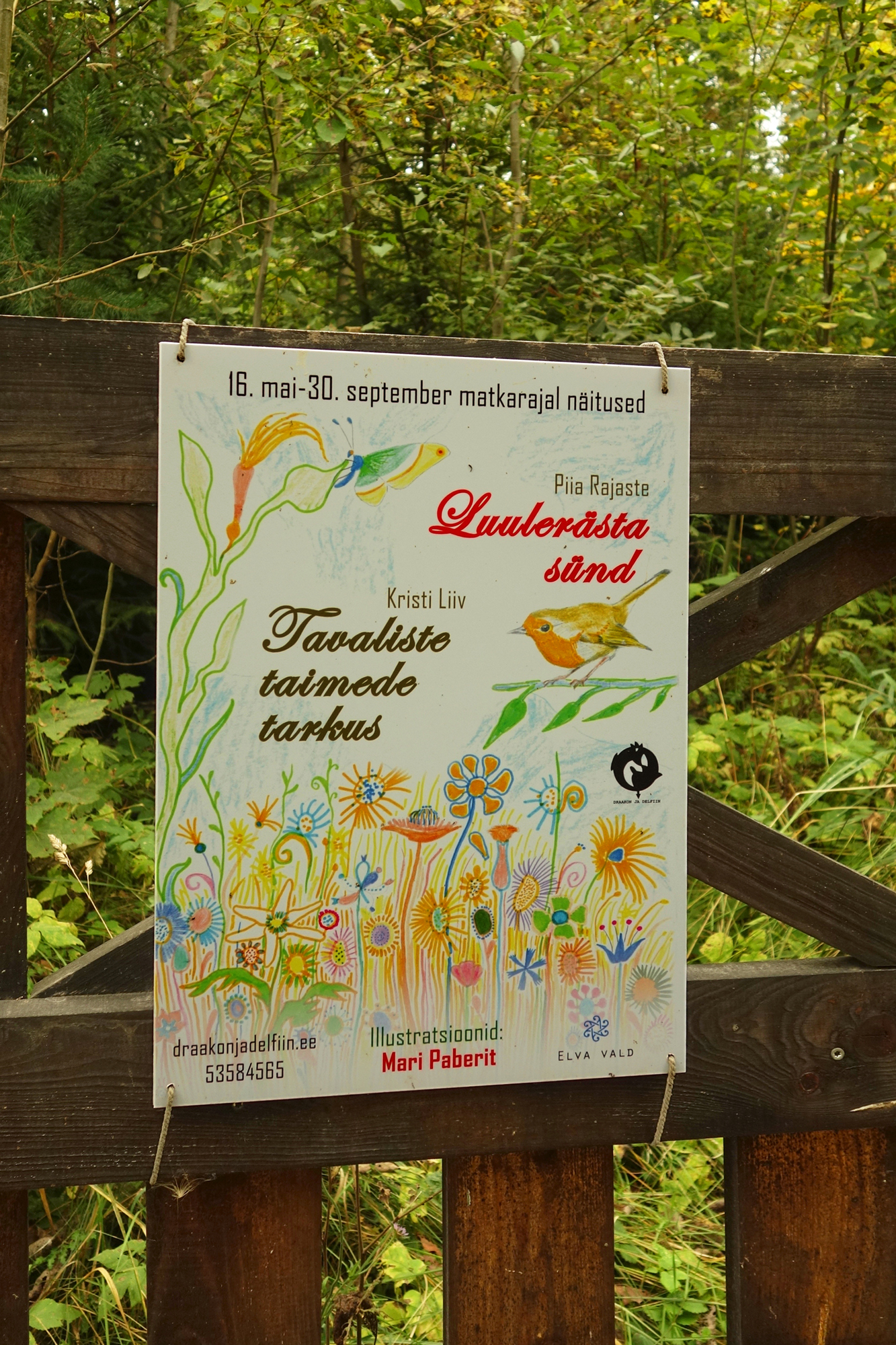Kobilu
After taking a look at the gently collapsing Soova mill, we walk back along the road for about 200 m and turn to Soova road. An old milestone stands by the road.

We are in Mäeselja village. Mäe-Auni, Auni, Uue-Laari and Suuretamme farms on the left, a road to Mäe farm starts here, a green wall of Metsalaane farm is visible from among the trees.
The road takes us up the hill and then diverges into two: the right-hand path leads to Puhja cemetery in 1.4 km. The cemetery was established in the 1840s.


We head straight towards Kobilu, walking briskly on until the path surprisingly comes to an end.

The Land Board’s map certainly says nothing about this. We find ourselves in the courtyard of Lootare farm, lost. Luckily the farmer is at home and explains that the place where the road used to run is now his agricultural land. However, he kindly leads the pilgrims through the spinney to the fields where the disrupted path continues.
Kalle insists that travellers let him know about their arrival so he could lock up his lovely big dog. (Lootare farm owner Kalle: Tel. 5119782)
.jpg)
And here we are ─ in a field of peas! No paths anywhere, only the seemingly endless field and Kobilu far away on the other side. We walk amongst peas, moan about the hot weather and pop peas into our mouth until we reach, quite exhausted, the Mõisa road near the Tartu Foods poster, alley of linden trees and stables.
Sitting later at Alt-Laari hill fort we realised that the trek across shrubs and pea field was not actually so tiring. No pilgrimage, after all, should be totally smooth.


We turned left on the Mõisa road and came to the courtyard of the company „Viljameister” (Grain Master), where we chanced upon the owner of the field we just crossed, Ahti Aruksaar. He has been nominated as the best rye grower in Estonia several times. We learned that the road on the Land Board map indeed did not exist, and there are fields instead. Apparently we had crossed a pea field of 123 ha.


We were standing in the courtyard of the former prosperous farm – Kobilo manor. The manor owned 446 ha of land, there were several dozen horses in the stable. The owner was Julius Heinrich von Dehn (1899–1971), married to Thessa Jette Bertha Rotermann (1907–1996), daughter of the wealthy industrialist and merchant Christian Ernst August Rotermann (1869–1950). The farm was established on the lands of the old Kobbilo cattle farm.
The course of history turned the life of this efficient and progressive farm upside down.
On 23 August 1939 the Soviet Union and Germany signed the Molotov-Ribbentrop pact (a non-aggression pact and a secret additional protocol that divided up Eastern Europe). After World War II broke out in September 1939, the Red Army marched into Estonia already in mid-October. German citizens and Germans residing here were allowed to resettle in Germany. They left behind empty houses and most of their possessions.
A newspaper dating from October 1939 wrote that the owner of the Kobilo manor, Julius Dehn, donated a horse cart load of books to the local library upon his departure. The manor and its 77-strong cattle and horses were taken over by others.
The stone and red-brick auxiliary buildings of the manor have partially survived and have been renovated. A propaganda film glorifying collectivisation that won the Stalin award „Valgus Koordis” (1951) was filmed here.
Currently an enterprise owned by Ahti Aruksaar operates here.
Close to Kobilu, another well-known farmer has settled here. Madis Ajaots established a successful plant cultivation business in Rannu in Tartu County, OÜ Rannu Seeme.
Konguta state collective farm went bankrupt in 1993 and Madis Ajaots had the chance to purchase one building and some land. He is known for experimenting with new plants; Rannu Seeme has over 2000 hectares for seeding. Madis Ajaots has received several awards, such as Farmer of the Year in 2010 and 2018, Best Plant Grower in 2017 etc.

Kobilu stone cross
A big stone cross stands by the Puhja–Konguta road, about 500 m from Kobilu bus stop towards Puhja.
Madis Ajaots told us how they were picking up and removing stones from a Kobilu village field in 2019 when the tractor came upon a particularly heavy stone. It turned out to be a stone cross. The cross was taken from the field, carefully cleaned, and on 30 April was put back on the same spot where it was found, according to old descriptions. The cross stands there for all to see.

2 photos: Taivo Toomsalu, 2019.
Huge stone crosses by the road
These crosses were probably put up on an old grave or in memory of a Swedish general killed in the Great Northern War (1700–1721) or all the killed solders. A cross could also warn people against stealing grain from the field.
According to the folklorist Marju Kõivupuu, such crosses were put by the road to show that this is a Christian country and also that people could talk to their God if they so wished – churches and chapels were sometimes far away.
The pilgrimage route introduces other large stone crosses near the Puhja church portal and in the wall surrounding the church, and by the Tartu–Võru road on the slope of Tatra valley. The last stone is called a Salt Eater’s stone.
Our next destination are Konguta hill forts; only a few km from Kobilu manor to Alt-Laari hill fort. The road takes us past the tall Kobilu grain dryers, continues straight on down into Kavilda river valley and in the distance rises majestically to the heaven.
Kavilda river seems quite overgrown in the valley, although its waters nevertheless make pleasant sounds. After crossing the river we pass the signpost of Kivistiku farm.


Daila Aas, 2022
Sources
https://register.muinas.ee/public.php?menuID=monument&action=view&id=4266
https://www.kalmistud.ee/Puhja-kalmistu-2
https://core.ac.uk/reader/237084740
https://www2.kirmus.ee/biblioserver/index2.php?kid=434596
https://www2.kirmus.ee/biblioserver/index2.php?kid=435424
https://pollumeheteataja.ee/uudis/2018/01/24/30-aastaga-eesti-seemnekasvatuse-tippu/
https://leht.postimees.ee/6736875/tartumaa-pollumees-madis-ajaots-kasvatab-ainsana-eestis-kikerherneid
https://epkk.ee/madis-ajaots-teraviljakasvataja-kes-usub-koostoosse/
https://maaleht.delfi.ee/artikkel/86989513/omaaegse-klantsfilmi-valgus-koordis-poldudel-kasvab-rekordrukis
https://maaleht.delfi.ee/artikkel/86091029/fotod-pollutoode-kaigus-leiti-kobilu-kula-lahedalt-kivirist
https://eelis.ee/default.aspx?state=2;-294849174;est;eelisand;;&comp=objresult=parandobj&obj_id=-387662782
https://et.wikisource.org/wiki/Esivanemate_ohverdamised/P%C3%BChad_kivid
Matthias Johann Eisen. Eesti mütoloogia. Pegasus, 2019.
https://draakonjadelfiin.ee/front/kivistiku-talukoha-suveprogramm/
